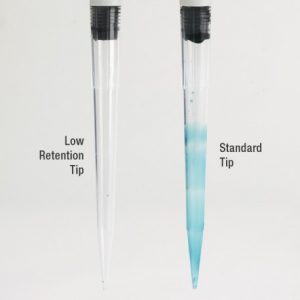The precision and accuracy of even the best calibrated pipette can be wiped out if you choose the wrong kind of tips. Depending on the experiment you are doing, the wrong kind of tips can also make your pipette a source of contamination, lead to waste of precious samples or reagents—or even cause you physical harm in the form of repetitive stress injury (RSI). There are so many different kinds of tips to choose from. How do you know which is the best for your pipette and situation? Never fear, that’s what we are here for.
- 1) Choose High quality pipette tips for precision and accuracy
- 2) Universal or Pipette specific tips?
- 3) Filter & Non-filter pipette tips. Advantages & Inconveniences
- 4) Low retention tips
- 5) Ergonomic tips
1) Choose high quality pipette tips for precision and accuracy
The first consideration that tends to spring to mind when thinking about which tip type to choose is precision and accuracy. If there is any batch-to-batch, or within batch, variation in the shape of the pipette tips, then your pipetting will not be precise. The accuracy of your pipette can be affected if the tip does not fit your particular pipette properly. If there is a poor seal between your pipette barrel and tip, then the drawn-in air can escape and the correct volume of liquid is not aspirated. Therefore, the final volume dispensed is not absolutely correct. Choosing a tip that is a good fit for your pipette can be a tricky business.
Which brings us to the question….

2) Universal or Pipette-specific tips?
The best option for your pipette and application is to use high-quality universal tips. These universal tips can be used with most micropipettes on the market. Universal tips are designed to fit securely and tightly around all pipette barrels, which vary slightly in diameter from manufacturer to manufacturer. For example, tips with FlexFit technology are flexible at the proximal end of tip (i.e., closest to the barrel), which gives them a better fit with a wider range of pipette types. In Labclinics, you can find universal tips with all the features discussed below (aerosol barrier, graduated, ergonomic, etc.).
3) Filter & Non-filter tips. Advantages and inconveniences
Barrier tips, or filter tips, are designed for different conditions. If you will be pipetting something that could contaminate your pipette—for example volatile, corrosive, or viscous chemicals—then you’ll want to consider barrier tips to protect your pipette and your samples.
Filter tips prevent PCR contamination
Aerosol Barrier tips, also called filter pipette tips, are fitted with a filter inside the proximal part of the tip. The filter protects your pipettes from aerosols and aspirating volatile or viscous solutions into the barrel, all of which can contaminate and damage the pipette. These tips usually come pre-sterilized and DNase/RNase-free. However, “barrier” is a bit of a misnomer for some of these tips. Only certain high-end tips provide a true sealing barrier. Most filters only slow the liquid from entering the pipette barrel. The filter barrier in these tips make them the choice for sensitive applications, like qPCR. The barrier prevents PCR contamination by stopping sample carryover from the pipette, which will give you more robust results. Also, remember to run your PCR positive control and negative control to find sample carryover. In addition, filter tips are good ‘training wheels’ for newbies. Many times pipette contamination occurs when a new lab member accidentally aspirates liquid into the pipette itself. It is much easier, and cost effective, to throw away a tip than to send the entire pipette in for repair because liquid is in the piston.

4) Low retention tips
No matter which tip you choose, low-retention is a key feature. Low-retention tips do exactly as the name suggests—retain low levels of liquid. If you’ve ever looked at a standard pipet tip, you might see a little bit of liquid left after dispensing. Low-retention tips reduce this from happening because they have a hydrophobic plastic additive that keeps the liquid from sticking to the inside of the tips.
5) Ergonomic Tips
Doing repetitive tasks, like pipetting, can cause damage to joints and result in repetitive stress injury (RSI). In light of this, companies have designed ergonomic tips that require lower insertion and ejection forces and, therefore, reduce the risk of RSI. That said, this feature all goes back to good fit. A tip that is specifically designed to fit your pipette properly is by definition an ergonomic tip.

Post time: May-10-2022

